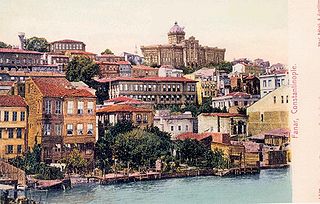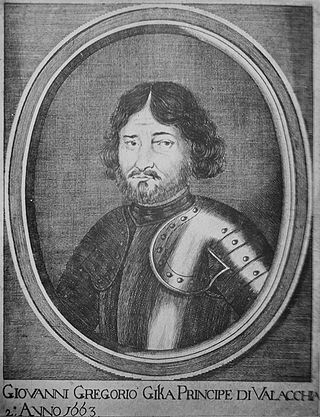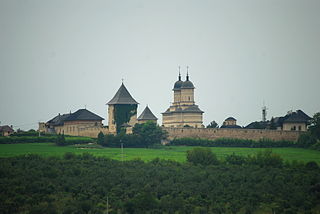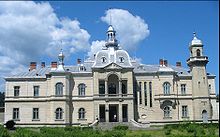
Moldavia is a historical region and former principality in Central and Eastern Europe, corresponding to the territory between the Eastern Carpathians and the Dniester River. An initially independent and later autonomous state, it existed from the 14th century to 1859, when it united with Wallachia as the basis of the modern Romanian state; at various times, Moldavia included the regions of Bessarabia, all of Bukovina and Hertsa. The region of Pokuttya was also part of it for a period of time.

Wallachia or Walachia is a historical and geographical region of modern-day Romania. It is situated north of the Lower Danube and south of the Southern Carpathians. Wallachia was traditionally divided into two sections, Muntenia and Oltenia. Dobruja could sometimes be considered a third section due to its proximity and brief rule over it. Wallachia as a whole is sometimes referred to as Muntenia through identification with the larger of the two traditional sections.

Lupu Coci, known as Vasile Lupu, was a Voivode of Moldavia of Albanian and Greek origin between 1634 and 1653. Lupu had secured the Moldavian throne in 1634 after a series of complicated intrigues and managed to hold it for twenty years. Vasile was a capable administrator and a brilliant financier and was soon almost the richest man in the Christian East. His gifts to Ottoman leaders kept him on good terms with the Ottoman authorities.

George Ghica founder of the Ghica family, was Prince of Moldavia in 1658–1659 and Prince of Wallachia in 1659–1660.

Phanariots, Phanariotes, or Fanariots were members of prominent Greek families in Phanar, the chief Greek quarter of Constantinople where the Ecumenical Patriarchate is located, who traditionally occupied four important positions in the Ottoman Empire: Voivode of Moldavia, Voivode of Wallachia, Grand Dragoman of the Porte and Grand Dragoman of the Fleet. Despite their cosmopolitanism and often-Western education, the Phanariots were aware of their Greek ancestry and culture; according to Nicholas Mavrocordatos' Philotheou Parerga, "We are a race completely Hellenic".

The House of Cantacuzino is a Romanian aristocratic family of Greek origin. The family gave a number of princes to Wallachia and Moldavia, and it claimed descent from a branch of the Byzantine Kantakouzenos family, specifically from Byzantine Emperor John VI Kantakouzenos. After the Russo-Ottoman War of 1710–11, a lateral branch of the family settled in Russia, receiving the princely status. In 1944, Prince Ștefan Cantacuzino settled in Sweden, where his descendants form part of the unintroduced nobility of that country.

Grigore Alexandru Ghica or Ghika was a Prince of Moldavia between 14 October 1849, and June 1853, and again between 30 October 1854, and 3 June 1856. His wife was Helena, a member of the Sturdza family and daughter of Ioan Sturdza, who had been Prince of Moldavia from 1822 to 1828.

Grigore I Ghica, a member of the Ghica family, was Prince of Wallachia between September 1660 and December 1664 and again between March 1672 and November 1673.

Voivode George Ducas was three times prince of Moldavia, one time prince of Wallachia (1674–1678) and one time Hetman of Ottoman Ukraine (1681-1683).

Grigore II Ghica was Voivode (Prince) of Moldavia at four different intervals — from October 1726 to April 16, 1733, from November 27, 1735 to 14 September 1739, from October 1739 to September 1741 and from May 1747 to April 1748 — and twice Voivode (Prince) of Wallachia: April 16, 1733 – November 27, 1735 and April 1748 to September 3, 1752. He was son of Matei Ghica.
Albanians in Romania are an officially recognized ethnic minority, with one seat reserved in the Romanian Chamber of Deputies to the League of Albanians of Romania.
Freemasonry in Romania traces its origins to the 18th century. Following an intricate history, all organised Freemasonry in the country ceased during the Communist era, although some lodges continued to operate in exile overseas. Freemasonry returned to Romania in the 1990s.
The Moldavian Revolution of 1848 is the name used for the unsuccessful Romanian liberal and Romantic nationalist movement inspired by the Revolutions of 1848 in the principality of Moldavia. Initially seeking accommodation within the political framework defined by the Regulamentul Organic, it eventually rejected it as imposed by foreign powers and called for more thorough political reforms. Led by a group of young intellectuals, the movement was mostly limited to petitioning and constitutional projects, unlike the successful uprising taking place later that year in neighbouring Wallachia, and it was quickly suppressed. This was despite the fact that the Moldavian revolutionaries were more moderate and willing to compromise in their demands for reforms than their Wallachian counterparts, as Moldavian political and social life continued to be dominated by a landed, conservative aristocracy, with the middle class still embryonic.

The House of Kogălniceanu, Kogălniceanul or Cogâlniceanu was one of the major political, intellectual and aristocratic families in Moldavia, with branches in modern Romania. Originally Bessarabian peasants, the first Kogălniceanus accumulated wealth and, as owners of the Scrivulenii (Râpile) estate, climbed into the boyar elite. They were also important as skilled members of the Moldavian bureaucracy, and, through brothers Constantin and Enache, also made contributions to 18th-century Romanian literature. Their work was matched and surpassed three generations later by possibly the most famous member of the family, historian and statesman Mihail Kogălniceanu, one of the founders of modern Romania and of Romanian liberalism.

Constantin Cantacuzino was a Romanian nobleman and historian who held high offices in the Principality of Wallachia. He was a humanist scholar who drew the first local map of Wallachia in 1700, and started to write a History of Wallachia which remained unfinished. In his History of Wallachia, he "accepted a Daco-Roman mixing" in connection with the origin of the Romanians. A promoter of a prudent anti-Ottoman policy, he was executed together with his son Ștefan.

Constantin G. Cantacuzino, also known as Costache Cantacozino or Costandin Cantacuzino, was the Caimacam (Regent) of Wallachia in September 1848–June 1849, appointed directly by the Ottoman Empire. A member of the Cantacuzino family, he had emerged as a leader of the conservative boyardom during the Regulamentul Organic period. As a commander in the Wallachian militia, he organized in 1831 the first elections for Bucharest's Town Council, and subsequently served as one of the Bucharest Governors. He first played a major part in national government from 1837 to 1842, when he served Prince Alexandru II Ghica as Postelnic and Logothete. During that interval, he clashed with his own brother Grigore Cantacuzino, who sided with the liberal current.

Gheorghe Balș was a Romanian engineer, architect and art historian.

The Paharnic was a historical Romanian rank, one of the non-hereditary positions ascribed to the boyar aristocracy in Moldavia and Wallachia. It was the local equivalent of a cup-bearer or cześnik, originally centered on pouring and obtaining wine for the court of Moldavian and Wallachian Princes. With time, it became a major administrative office and, in Wallachia, also had a lesser military function. The retinue of such boyars, usually called Păhărnicei, was in both countries also a private army.
Dumitrașcu Cantacuzino was Prince of Moldavia 1673, 1674 to 1675, and 1684 to 1685.

Gregory Callimachi was a Phanariote who served as Prince of Moldavia from 1761 to 1764, and 1767 to 1769.
























